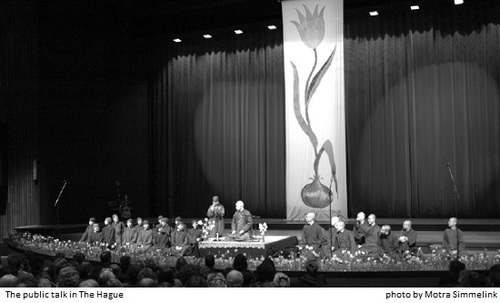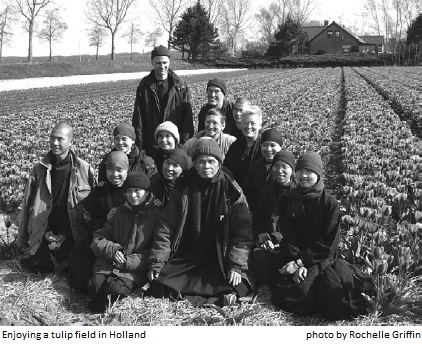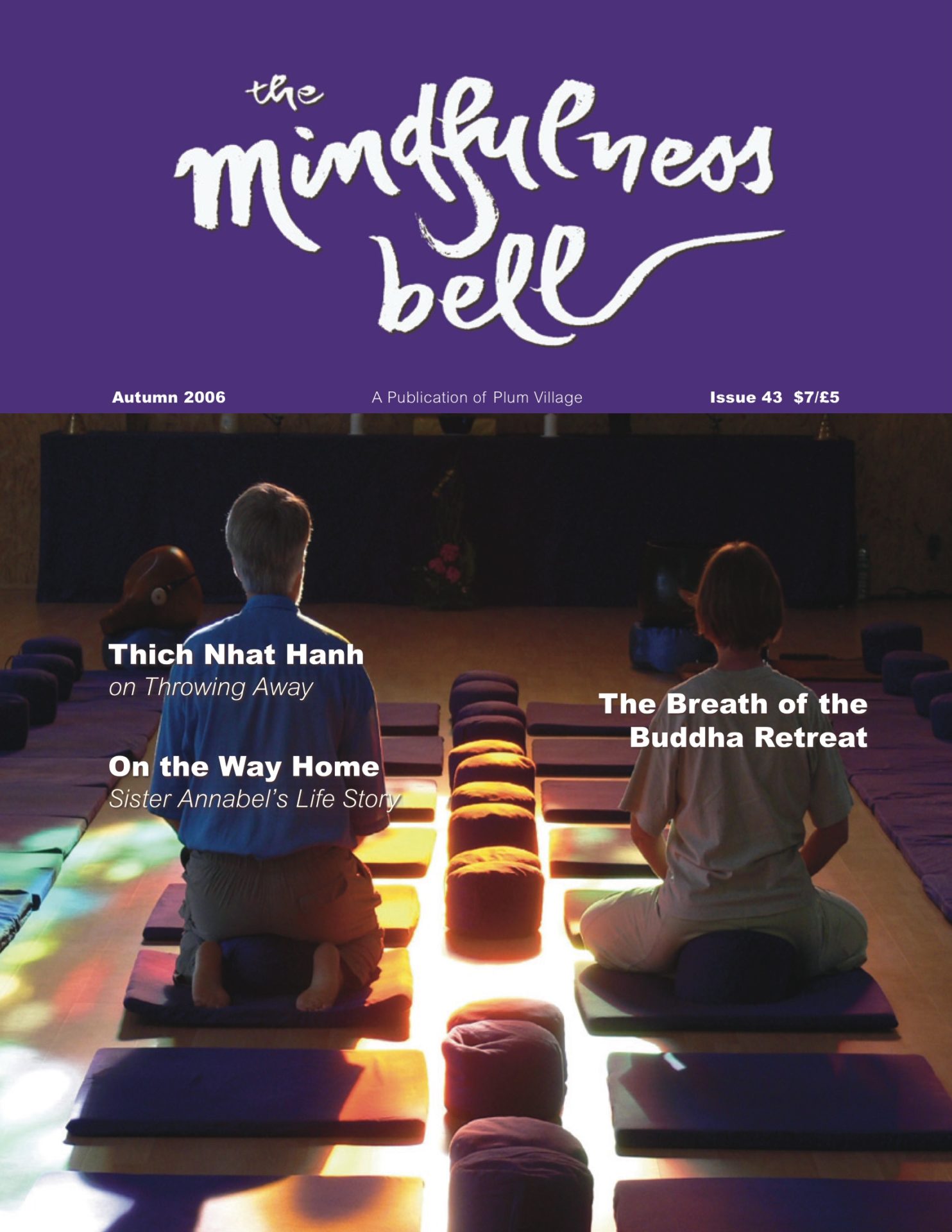Thây in the Netherlands
In the spring of this year Thây came with a delegation of 30 monastics from Plum Village for a ten-day visit to the Netherlands. Both the public talk, ‘Peace Is Every Step’, in The Hague and the five-day retreat in Oosterbeek near Arnhem were sold out. Many people made Thây’s visit and the retreat a wonderful and joyful practice. New sanghas are starting, local sanghas, but also a peaceworkers’ sangha.
Thây in the Netherlands
In the spring of this year Thây came with a delegation of 30 monastics from Plum Village for a ten-day visit to the Netherlands. Both the public talk, ‘Peace Is Every Step’, in The Hague and the five-day retreat in Oosterbeek near Arnhem were sold out. Many people made Thây’s visit and the retreat a wonderful and joyful practice. New sanghas are starting, local sanghas, but also a peaceworkers’ sangha. Sleeping sanghas wake up again, and small sanghas grow. It is clear that Thây’s visit to the Netherlands brought new inspiration to the Dutch sangha. Here are fragments of personal reports by participants. For reflections by young retreatants, see “Children’s Voices” on page 29.

Preparations for the Public Talk in The Hague
Along the edge of the stage: 22 meters of transparent glass vessels topped by yellow daffodils. Behind it, the warm red velvet of the curtain. A white banner with a painted tulip hangs from ceiling to floor: roots, bulb, stalk, and 10 meters above the floor, the flower. In between, the brown of the monastics with their bright faces, the sun. This is the image that 2000 people see from the auditorium.
The basic idea popped up in the intimacy of Didi’s small car: ‘The window sill’, a typical Dutch feature, ‘with flowering tulip bulbs on it’. The tulips turn out to be too expensive. The idea changes, we replace the tulip bulbs with daffodils.
We start collecting glass jars and bottles. At recycling containers we stand and ask people to give us their jars and bottles: a good exercise in humility. For many weeks bags and boxes full of dirty glassware wait to be cleaned. We start loving these glass forms, the beauty of their brightness and simplicity.
On April 28, we drive to our friend Pim. Due to a late spring this year in Holland, the yellow trumpets are still there at the end of April. With shoes wet from the dew, we pass through the bulb fields. In The Hague it takes us all afternoon to get water, glass jars, and flowers in the right place. The banner with the beautiful tulip in the middle of the stage hangs brilliantly. At 6 p.m. we’re finished, ready to enjoy the lecture, the singing, and the sight of this stage. And we think about what we have experienced in turn: humility and dirt, cleaning and brightness, transformation and joy.
—Gré Hellingman and Didi Overman
The Lecture, “Peace Is Every Step”
On the evening of the talk it was very busy in The Hague. The town is the residence of the government and that day it celebrated the eve of ‘Queen Day’ (the birthday of the Queen). Our group of students from the agronomy university reflects a broad segment of the audience that feels touched by Thây’s message that “the best way to take care of the future is to take care of the present.”

While 2000 people slowly fill the room, a number of nuns and monks are sitting in meditation on the podium. Hundreds of daffodils provide color and joy.
Thich Nhat Hanh calmly walks onto the podium and takes his place on a meditation cushion. We are requested to mindfully watch our breathing, while on the podium there is singing accompanied by the vibrating tones of a bell. I feel the hall gradually becoming calmer. Some people welcome this peacefulness very much indeed: in front of me two men start to fall asleep.
Thây starts to tell about the merits of walking meditation. ‘Walking meditation helps us to get into the now.
Often we are a little ahead or behind. Our thoughts are in the future or the past, while our life is only in the present moment.’ Thây speaks about the importance of deep listening and loving speech in dealing with lonely desperate youth, and even with violent extremists. He also talks about his peace work with Israelis and Palestinians.
After the talk the audience is invited to take a souvenir. On the train back, I see daffodils here and there. Tonight Thich Nhat Hanh has clearly touched and inspired a lot of people.
—Barbara Tieleman
The Retreat in Papendal, Oosterbeek, May 1-5
To me as a newcomer, the five-day retreat was like an intensive course in slow and mindful living. Incredible what Thây, the monastics, and the Dutch organization managed to fit into the program! Every day eating in silence (amidst pictures of Olympic sportsmen), a guided sitting meditation, a dharma talk, walking meditation, and discussion in the families. In addition, ‘beginning anew’, ‘touching the earth,’ and the taking of the Five Mindfulness Trainings (by almost 200 people!).
In his dharma talks, Thây elaborated on issues touched upon in the public talk, such as living in the here and now, and overcoming hostility by deep listening and loving speech. During the week Thây tuned his talks more and more to the current harsh Dutch political atmosphere. He did so in a positive, encouraging and inspiring way.
On May 4, Memorial Day, some younger and older participants told their personal stories of war, peace, conflict, and reconciliation. (The retreat was located in a spot where 61 years ago, bombs had fallen.) That evening we celebrated peace with a candlelight procession and we sang peace songs in the open air. There was a festive atmosphere in Oosterbeek.
—Wilma Aarts
Snapshots of the Retreat
Snatches flutter through my head and heart, songs I hear myself sing when I ride my bike, images on my retina. Some fragments...
In his talk on making peace Thây stands rocking the baby of pain in his arms, saying to it: “I’ll take good care of you. I don’t know yet what is wrong with you, whether you are lonely or angry, but I know that you are in pain. With my full attention, I will be with you, I do not leave you alone.”
Thây sketches the image of a friend, an American peace activist, who is in a coma in a hospital. In his last hours Thây and Sister Chan Khong visit him, massage his feet and remind him of all the good peace work he did. And Sister Chan Khong sings for him the song she sings for us now: ‘No Coming, No Going’.
The island in ourselves, a place of comfort and renewal we can return to, before we step into the outside world. In his talk Thây describes the island in ourselves. And then we sing the new, Dutch version of this song. The young Dutch monk who sings so beautifully leads the singing and we follow.
Children around Thây, helping each other to entwine their little fingers into mudras. It is almost still, a pigeon coos, a giggle. Thây loans his bell to a child. Very mindfully he mimes inviting the bell, the unhearable sound of the invisible bell.
—Else Meerman

